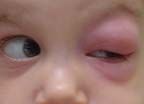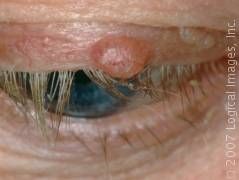![]()
![]()
![]()
Use LEFT and RIGHT arrow keys to navigate between flashcards;
Use UP and DOWN arrow keys to flip the card;
H to show hint;
A reads text to speech;
13 Cards in this Set
- Front
- Back
|
Name some eyelid disorders (8)
|
1. ectropion
2. entropion 3. blepharitis 4. stye (hordeolum) 5. chalazion 6. dermatitis 7. BCC 8. orbital cellulitis 9. acne rosacea 10. new: LICE INFESTATION |
|
|
Blepharitis
- definition, cause, risk factors - symptoms |

- Strictly: Inflammation of eyelid, but only considered blepharitis when it involves exces lipid secretions. Due to some or all of:
- Meibomianitis (inflammation of the meibonian gland) - Staph infection or meibomian gland - seborrhoea (excess sebum) (2) Risk factors: poor hygeine, occupational dirty hands, dandruff - typically BILATERAL with possible: irritation, itching, burning, excess tears, crusty debris, skin flakes around eye lashes, esp on waking **NB: Meibomian gland is a sebaceous gland of the eyelid |
|
|
Hordeolum - what's that, what causes it, symptoms
|

A STYE. Infection of eyelid gland, usually by staph aureus or epidermis, may be
(a) external: ciliary gland (an eyelash gland) (b) internal: mebonium gland & very rare Symptoms - Swollen upper or lower eyelid, painful/sensitive, sometimes associated conjunctivitis |
|
|
Chalazion
- explain |

Uncommon. A chronically inflammed granuloma of a meibomiam gland, evolves from an internal stye.
They are painless lumps - key for differentiation Also initially (first 1-2 days) may be indistinguishable from a stye until they locate to the eyelid instead of the eyelid edge |
|
|
How do you differentiate a stye and a chalazion?
|
Chalazions are painless, they lack a head of pus at the lid margin
|
|
|
What disease state tends to be associated with a hordeolum and which with blepharitis?
|
- with conjunctivitis: stye
- with psoriasis or dandruff: blepharitis |
|
|
An important differential diagnosis for blepharitis?
|
Contact/irritant dermatitis
1. question about recent use of products around eye 2. Rosacea 3. LICE INFESTATION - smother the lice with a bland opthalmic ointment for TEN days |
|
|
An important differential diagnosis for hordeolum (stye)?
|

Orbital cellulitis: usually a complication from a sinus infection, unilateral, both eyelids swollen, sometimes restricted eye movement
|
|
|
Characteristics of BCC of eyelid?
|

1. nodular, reddish, painless, usually lower lid,
2. Often also loss of eyelashes at the spot 3. Hx of sun exposure especially in middle aged or elderly |
|
|
Blepharitis
- Treatment |
Improved lid hygeine DAILY:
1. mild shampoo (baby shampoo diluted 1:10) applied with a cotton bud applied directionally towards the eye ** Alternatively use Lid-Care, available as a solution applied to a pad or as actual pads. ** Or 1tsp bicarbonate in 250ml hot tap water 2. For moderate or chronic cases, antibiotics might help ** Bleph-10, 2 drops to eyelid margin bd-tds ** Chlorsig oint bd-tds 3. If there is a lot of discomfort, antibiotic drops plus steroid combo bd-tds as ointment or drops |
|
|
What if blepharitis doesn't go away?
|
Refer. May be related to
1. rosacea 2. Herpes SIMPLEX 3. fungal infection |
|
|
Hordeolum / Stye
Treatment |
1. Warm compress 5-10mins tds - qid - helps an external stye point and burst
2. topical abx dont help 3. incision if doesn't go away on own 4. oral abx if cellulits occurs |
|
|
Chalazion
Treatment Will abx help? |
1. as for hordeolum, warm compress 5-10 min tds-qid & digital massage may help to break it up (may take a few weeks to resolve completely)
2. If particularly bothersome, a referral for surgical incission and curettage or intrachalazial triamcinolone NO! not infectious; just a residual pile of immune cells and debris |

